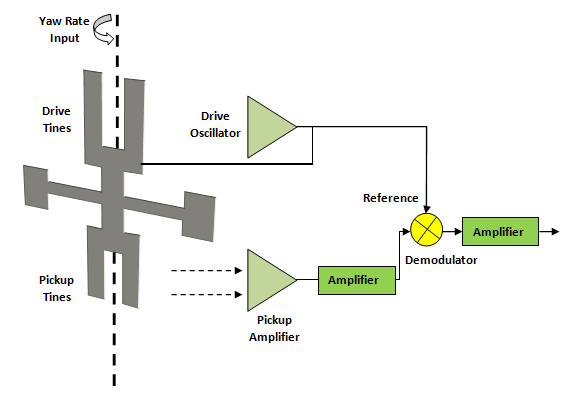Angular Rate Sensors
- Basic Description
-
Angular rate sensors measure a change in angular
velocity about an axis in degrees per second or radians per
second. These instruments use vibrating structure gyroscopes.
The main automotive application of these sensors is to determine the yaw (vehicle rotation about its vertical axis) or roll (vehicle rotation about its lengthwise horizontal axis) angle of the vehicle. These sensors play a key role in electronic stability control systems. Two types of angular rate sensor are used for automotive applications.:
-
Piezoelectric: This type of sensor consists of a tuning fork shaped structure containing four piezo elements, two on the top and two below, which is driven at a set frequency by the drive oscillator. While driving on a straight path, the upper piezo elements do not generate a disruption in the frequency because there is no existing Coriolis force. When cornering, the orientation movement causes the upper part of the tuning fork to leave the oscillatory plane, causing a deviation in frequency. The pickup signal is amplified and demodulated to determine the difference between the oscillation frequency and the frequency at which it is being driven. An additional stage of amplification and processing allows the sensor to generate a voltage proportional to the yaw rate and oscillatory speed. The polarity of the voltage is determined by the cornering direction (left or right).

Yaw Rate Sensor System
MEMS (Microelectromechanical Systems): In this type of sensor,
a micro-mechanical capacitive acceleration sensor is placed on an oscillating
element. The measured acceleration is proportional to the product of angular rate
and the oscillatory velocity.
Due to their small size and relative low cost, MEMS devices have dominated the automotive market in the past few years.
A third technology known as Fiber Optic Gyro (FOG) rate sensors is used in aerospace systems, but is currently too expensive for automotive applications. FOG rate sensors operate using a fiber optic ring and a solid-state laser to measure rotation rates using the Sagnac effect, first discovered in 1913. Sagnac discovered that light sent around a closed loop, in two different directions, would show a phase difference between the two beams when the loop is rotated. FOG sensors have no moving parts. They are durable and stable with time and temperature.
- Manufacturers
- Analog Devices, Bosch, Continental, MicroStrain, Panasonic, Silicon Sensing, Standard, Systron, Tamagawa-Seiki, VBOX, Willow Technologies
- For More Information
- [1] Yaw Rate Sensor,
Wikipedia.
- [2] Vibrating Structure Gyroscope, Wikipedia.
- [3] Bosch Angular-rate Sensor SMG10x for Rollover Application, YouTube, Mar.22, 2011.
- [4] Yaw-Rate Gyroscopes, YouTube, Sep. 1, 2011.
- [5] Vehicle Yaw Rate Estimation Using a Virtual Sensor, International Journal of Vehicular Technology, 2013.
|

